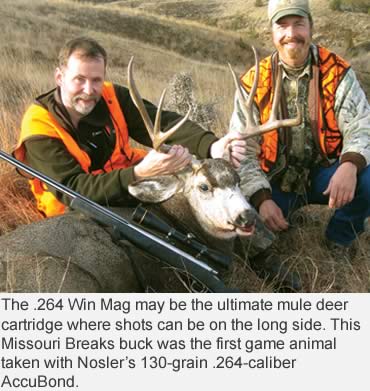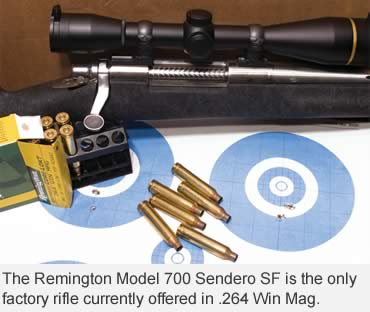This 50-year-old round has .270 Win power and even better long-range performance.
For the most part, the .264 Winchester Magnum has gone the way of the pet rock, but as a young hunter growing up in West Virginia, I always wanted a rifle in this caliber. Visions of traveling to Montana to hunt mule deer in the wide open spaces made the .264 seem like the gun to have. And “two sixty-four” has a ring to it, like “three twenty-seven” does to small-block Chevy owners.
The .270 Winchester was introduced in 1925 and has become one of the most popular hunting cartridges ever created. When Winchester decided to introduce a fast-stepping .264 cartridge in 1958, it’s a wonder it wasn’t the .270 Winchester Magnum. The same goes for Remington’s 7mm Magnum launched in 1962.
Along with the stiff competition, the .264 had several perceived strikes against it. One was a reputation as a barrel burner, eroding throats in as little as 100 firings. But the .264 wasn’t harder on barrels than the other magnums of the day. Another negative was the requirement of a 24-inch barrel for the cartridge to achieve advertised velocities. Still, it developed a dedicated fan base, and I could be considered a card-carrying member of the .264 cult.
There’s little difference in the terminal performance of the .264 Win Mag and the .270 Winchester, and duplicating .270 performance is never a bad thing. It’s doubtful any animal would notice the difference.
The .264’s longer, thinner bullets give it a slight ballistic edge over the .270, however. Compare the 130-grain .264 Swift Scirocco II with the same bullet in .277. Ballistic coefficients are .574 and .450, respectively. Fire both projectiles at the same speed, and the .264-inch bullet will be traveling 200 fps faster at 500 yards and 3 inches lower than the .270 pill.
Now, 3 inches of drop at 500 yards isn’t a big deal. What’s important is the higher impact velocity, which helps the .264 bullet expand at that range.
 When the speed of premium bullets falls below 2,000 fps, expansion becomes questionable. In fact, I tested this with the Scirocco II bullet and found a 20-percent difference in expansion at 1,800 fps and 2,100 fps. Also, as velocity increases, so does wound cavity volume and tissue destruction.
When the speed of premium bullets falls below 2,000 fps, expansion becomes questionable. In fact, I tested this with the Scirocco II bullet and found a 20-percent difference in expansion at 1,800 fps and 2,100 fps. Also, as velocity increases, so does wound cavity volume and tissue destruction.
So there’s the .264 Win Mag’s edge: higher retained velocity, more expansion and greater tissue destruction.
The .264 is versatile, too. You can launch a Hornady 95-grain V-Max to 3,500 fps and the Hornady 160-grain round nose to 2,800 fps. The most common .264 bullet is the 140-grainer. I used a 140-grain Berger VLD with a BC of .627 to take a red stag in New Zealand at 289 yards. The bullet hit just under the spine and penetrated the diaphragm, dropping the bull where it stood.
Premium .264-caliber 130-grain bullets are long for their weight. I used a 130-grain AccuBond in a Nosler Custom load to take the first big game animal to fall to that bullet.
When they come in the form of a Barnes Triple Shock or Nosler Partition, 120- and 125-grain bullets work well in the .264. Fired from a 24-inch barrel, the 120-grain Triple Shock generates about 3,300 fps and penetrates deep. On my first trip to Africa, I took a custom .264 rifle built by Charlie Sisk loaded with 125-grain Partitions and cleanly took a wildebeest cow and a nice bushbuck at 210 and 60 yards, respectively.
 Even lighter .264 bullets can be used with success. A friend borrowed my custom Sisk rifle in .264 Win Mag to carry on a Wyoming pronghorn hunt. Firing a 100-grain Nosler Ballistic Tip, he took a Boone & Crocket pronghorn at 150-plus yards, hitting the animal twice but seconds apart. Both bullets generated massive internal damage before exiting.
Even lighter .264 bullets can be used with success. A friend borrowed my custom Sisk rifle in .264 Win Mag to carry on a Wyoming pronghorn hunt. Firing a 100-grain Nosler Ballistic Tip, he took a Boone & Crocket pronghorn at 150-plus yards, hitting the animal twice but seconds apart. Both bullets generated massive internal damage before exiting.
Anytime I think about that custom Sisk rifle, it reminds me of the .264’s barrel-burning reputation. When I received the rifle, I purchased 100 cases, and according to my notes, reloaded them four times each. When I returned the rifle to Sisk following testing, there were 28 unfired cartridges remaining, but the rifle could still put three 100-grain Ballistic Tips into a group almost too small to measure. And get this: I never, ever cleaned the barrel of that gun!
The .264 may be lost in the media and marketing hype of the new short magnums and the reputations of its old rivals, the .270 Winchester and 7mm Remington Magnum. That doesn’t bother me at all, and apparently it doesn’t bother Remington because they recognize the cartridge still has a following and are chambering the Model 700 Sendero SF rifle for it. So far, I haven’t found a load that gun doesn’t like. It will shoot 140-grain Remington Core-Lokts into sub-inch groups all day.
When I was young and addicted to ballistic charts, I dreamed of a .264 Win Mag. It was still a few years before I began handloading, and the fact that a wide assortment of factory ammo was not available for the .264 resulted in my purchase of a .270 Winchester.
I expect others did the same. There are still not many .264 Win Mag factory loads available, but I will be shooting this cartridge for a long time, even if I have to handload every round.
This article was published in the September 2008 edition of Buckmasters GunHunter Magazine. Subscribe today to have GunHunter delivered to your home.








